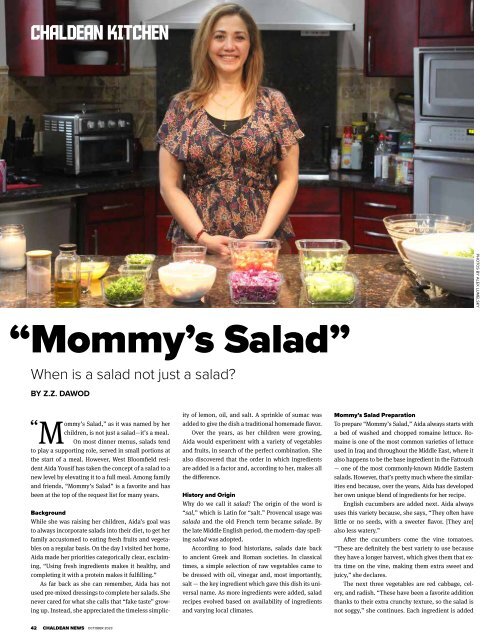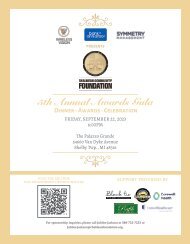Create successful ePaper yourself
Turn your PDF publications into a flip-book with our unique Google optimized e-Paper software.
CHALDEAN KITCHEN<br />
PHOTOS BY ALEX LUMELSKY<br />
“Mommy’s Salad”<br />
When is a salad not just a salad?<br />
BY Z.Z. DAWOD<br />
“<br />
Mommy’s Salad,” as it was named by her<br />
children, is not just a salad—it’s a meal.<br />
On most dinner menus, salads tend<br />
to play a supporting role, served in small portions at<br />
the start of a meal. However, West Bloomfield resident<br />
Aida Yousif has taken the concept of a salad to a<br />
new level by elevating it to a full meal. Among family<br />
and friends, “Mommy’s Salad” is a favorite and has<br />
been at the top of the request list for many years.<br />
Background<br />
While she was raising her children, Aida’s goal was<br />
to always incorporate salads into their diet, to get her<br />
family accustomed to eating fresh fruits and vegetables<br />
on a regular basis. On the day I visited her home,<br />
Aida made her priorities categorically clear, exclaiming,<br />
“Using fresh ingredients makes it healthy, and<br />
completing it with a protein makes it fulfilling.”<br />
As far back as she can remember, Aida has not<br />
used pre-mixed dressings to complete her salads. She<br />
never cared for what she calls that “fake taste” growing<br />
up. Instead, she appreciated the timeless simplicity<br />
of lemon, oil, and salt. A sprinkle of sumac was<br />
added to give the dish a traditional homemade flavor.<br />
Over the years, as her children were growing,<br />
Aida would experiment with a variety of vegetables<br />
and fruits, in search of the perfect combination. She<br />
also discovered that the order in which ingredients<br />
are added is a factor and, according to her, makes all<br />
the difference.<br />
History and Origin<br />
Why do we call it salad? The origin of the word is<br />
“sal,” which is Latin for “salt.” Provencal usage was<br />
salada and the old French term became salade. By<br />
the late Middle English period, the modern-day spelling<br />
salad was adopted.<br />
According to food historians, salads date back<br />
to ancient Greek and Roman societies. In classical<br />
times, a simple selection of raw vegetables came to<br />
be dressed with oil, vinegar and, most importantly,<br />
salt — the key ingredient which gave this dish its universal<br />
name. As more ingredients were added, salad<br />
recipes evolved based on availability of ingredients<br />
and varying local climates.<br />
Mommy’s Salad Preparation<br />
To prepare “Mommy’s Salad,” Aida always starts with<br />
a bed of washed and chopped romaine lettuce. Romaine<br />
is one of the most common varieties of lettuce<br />
used in Iraq and throughout the Middle East, where it<br />
also happens to be the base ingredient in the Fattoush<br />
— one of the most commonly-known Middle Eastern<br />
salads. However, that’s pretty much where the similarities<br />
end because, over the years, Aida has developed<br />
her own unique blend of ingredients for her recipe.<br />
English cucumbers are added next. Aida always<br />
uses this variety because, she says, “They often have<br />
little or no seeds, with a sweeter flavor. [They are]<br />
also less watery.”<br />
After the cucumbers come the vine tomatoes.<br />
“These are definitely the best variety to use because<br />
they have a longer harvest, which gives them that extra<br />
time on the vine, making them extra sweet and<br />
juicy,” she declares.<br />
The next three vegetables are red cabbage, celery,<br />
and radish. “These have been a favorite addition<br />
thanks to their extra crunchy texture, so the salad is<br />
not soggy,” she continues. Each ingredient is added<br />
42 CHALDEAN NEWS <strong>OCTOBER</strong> <strong>2023</strong>

















